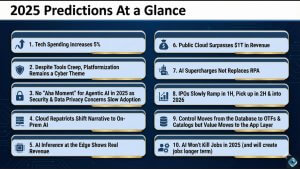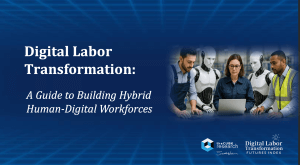Watch the Podcast here, or continue on to read a summary.
As enterprises rapidly embrace AI agents and agentic systems to revolutionize decision-making and automation, the question arises: Are Software Development Lifecycle (SDLC) solutions critical to the future of Agentic AI? As Agentic AI increasingly becomes central to business innovation, understanding how Software Development Lifecycle (SDLC) platforms intersect with AI development is becoming mission-critical for business and technology leaders. This market brief, informed by discussions with industry expert Paul Nashawaty on theCUBE Research’s “Next Frontiers of AI” podcast, explores the significance of SDLC methodologies within AI workflows, highlights potential challenges, and examines how software developer roles adapt to widespread AI adoption. We also explore:
- How is AI scaling developer productivity today?
- Are we seeing the emergence of a new role – AI software engineers?
- Will software developers also need to become data scientists?
- Will the complexity spectrum—from no-code to autonomous AI—dictate SDLC?
- When will SDLC platforms be critical, beneficial, or potentially overkill?
For a more detailed discussion, tune into the thought-provoking conversation on the Next Frontiers of AI podcast about how to best bridge traditional software engineering practices with the revolutionary demands of AI-driven innovation.
Scaling Developer Productivity
AI significantly enhances software development efficiency and cost-effectiveness by automating repetitive tasks, streamlining workflows, and increasing accuracy in coding and testing processes. AI-powered tools can quickly identify bugs, suggest optimal code, and predict potential system failures, substantially reducing the time and effort required from human developers. By minimizing manual intervention, organizations can allocate their developers to focus on higher-value, innovative tasks, improving overall productivity and competitive advantage.
The collaborative case study between AWS and IBM highlights these advantages. AWS’s Amazon Bedrock platform and IBM’s development methodologies were integrated to create a powerful automated software development lifecycle. By embedding Amazon Bedrock’s AI capabilities into IBM’s structured development processes, significant improvements in application deployment speed, scalability, and quality were achieved. This collaboration demonstrated clear financial benefits, including reduced operational costs, accelerated application releases, and improved software reliability, directly translating into measurable competitive advantages for clients.
- 30% reduction in development time
- 25% improvement in unit test generation
- 25% improvement in code quality
- 60% reduction requirements analysis
Paul Nashawaty highlighted this collaboration, noting:
“The AWS and IBM partnership exemplifies how integrating AI into structured SDLC processes can significantly accelerate software development and deliver immediate cost and quality improvements.”
You can read more about the collaborative solutions and its outcomes here.
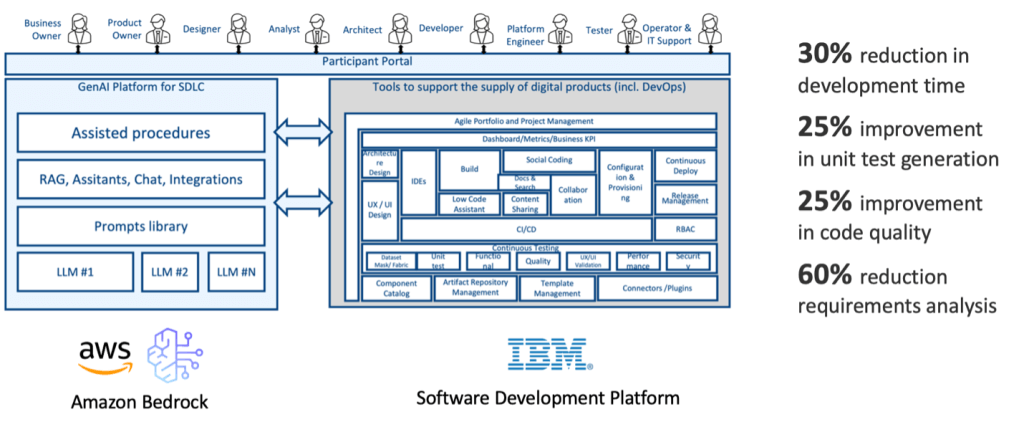
We anticipate that AI-powered software development lifecycles will grow in sophistication over time. Today’s capabilities, which focus on automating developer tasks, will evolve to support AI-guided decision intelligence that helps developers better plan and solve problems. This will ultimately lead to fully automated SDLC workflows where human developers collaborate with AI agents within agentic workflows. This progression of AI-driven automation will transform the application development landscape, fostering genuinely autonomous software factories that will accelerate outcomes, enhance quality, and build a more resilient capacity to adapt to change. This will inherently drive greater data science and AI skills for software developers.
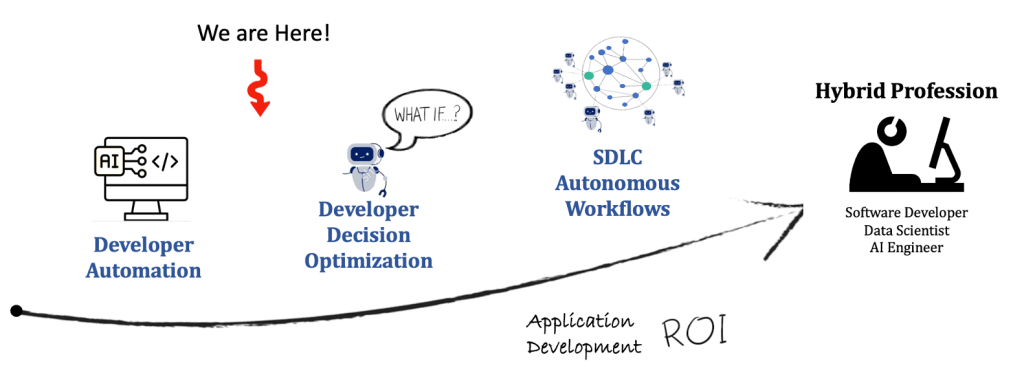
The Rising Complexity of Agentic AI
Let’s now shift to the role of SDLC platforms in the design, development, and lifecycle management of Agentic AI systems.
AI-driven applications, agents, and automation are rapidly advancing and becoming integral to core business processes. Unlike traditional software applications, these AI solutions must dynamically adapt, reason, learn, and make increasingly sophisticated decisions based on real-time data. Consequently, the role and complexity of the underlying software infrastructure supporting these AI capabilities are growing exponentially.
Paul Nashawaty underscores this complexity clearly, stating:
“As AI solutions become more sophisticated, the role and complexity of software in these systems must increase exponentially. Organizations can’t continue doing things the old way—they need structured lifecycle management to ensure quality and agility.”
While AI serves as an accelerator, enhancing productivity and efficiency across development teams, it also introduces heightened complexity. AI models are vulnerable to drift and bias without robust lifecycle management, significantly increasing business risk. Hebner noted:
“Poor lifecycle management is one of the primary reasons AI projects fail—causing model drift, bias, and governance issues..”
From here, AI-driven applications and Agentic AI systems are rapidly increasing in complexity, becoming central to solving highly sophisticated, real-world business problems. Unlike traditional software applications, these AI-driven solutions must dynamically interpret data, reason about implications, adapt to shifting conditions, and manage intricate interactions between multiple intelligent agents. As illustrated by the podcast discussion featuring BMW’s causal knowledge graph for supply chain management, modern AI solutions are pushing the boundaries of technological innovation.
BMW’s sophisticated causal knowledge graph demonstrates the complexity inherent in next-generation AI systems. Each entity within the knowledge graph dynamically understands and reacts to causal relationships, allowing the system to anticipate disruptions, optimize responses, and enhance operational resilience. This level of sophistication underscores that traditional development frameworks alone are insufficient.
As Hebner pointed out, “The complexity of multi-agent AI systems—especially those using semantic and causal reasoning—makes structured SDLC methodologies indispensable.”
The BMW example further clarifies the need for extensive, specialized software to coordinate interactions between complex AI models, data streams, and real-time conditions. The increased sophistication of these agentic systems necessitates robust and scalable software that serves as the unifying “glue,” orchestrating seamless interaction between various AI components and enabling coherent functionality across intricate systems.
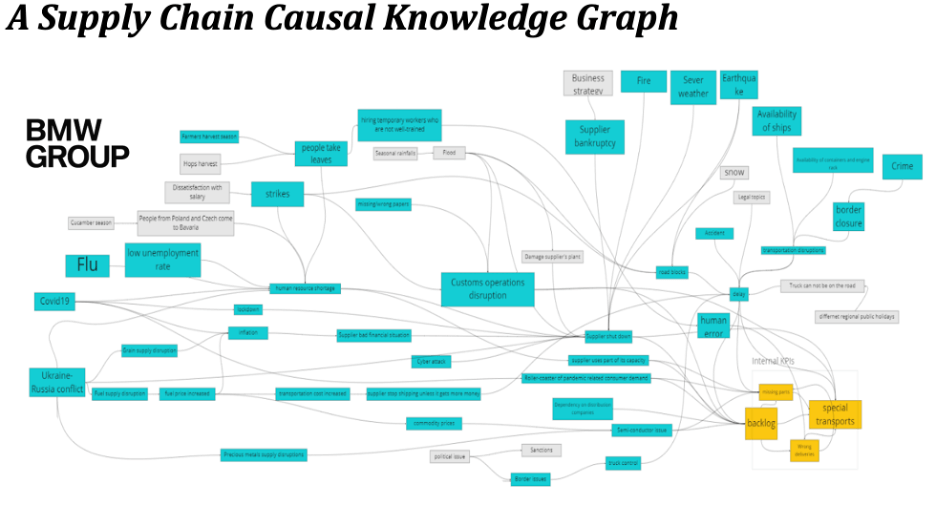
SDLC – Necessity or Overkill?
During the podcast, Nashawaty emphasized that integrating SDLC platforms into AI development is a competitive imperative, not an optional choice. Organizations that neglect structured development processes expose themselves to increased vulnerabilities, including unmanaged model drift, unchecked biases, and fragile AI integrations.
“Integrating SDLC into AI workflows isn’t optional anymore; it’s mandatory,” Nashawaty stresses. He elaborates, “If organizations ignore the structured discipline of SDLC, they’re setting themselves up for significant risks, operational inefficiencies, and competitive disadvantages.”
The structured discipline of SDLC—spanning design, development, testing, deployment, and management—mitigates these risks by ensuring consistency, reliability, and governance across AI applications.
Integrating SDLC platforms with Agentic AI, especially within low-code and no-code environments, is becoming essential. While these environments allow business professionals to develop simple AI-driven applications with minimal coding expertise—such as chatbots and robotic process automation—the complexity of maintaining, updating, and scaling these agents necessitates structured lifecycle management.
SDLC platforms provide crucial support across multiple dimensions:
- Project Management & Collaboration: Coordination among diverse stakeholders—data scientists, software engineers, and domain experts—requires robust workflow and documentation tools. Platforms such as JIRA or Azure DevOps enhance collaboration, ensuring AI model and software integration remain cohesive.
- Version Control & Model Management: AI agents evolve as they ingest new data and improve functionality. Tools like Git, GitHub, DVC, and MLflow facilitate model versioning and traceability, essential for accountability and auditability.
- Scalable & Modular Architecture: AI agents must integrate seamlessly with APIs, databases, and legacy enterprise systems. SDLC frameworks enable scalable, modular designs—leveraging microservices and containerization (Docker & Kubernetes) for deployment flexibility.
- Automated Testing & Validation: Rigorous testing is crucial to prevent biases, maintain accuracy, and assure performance. Continuous Integration/Continuous Deployment (CI/CD) pipelines, such as GitHub Actions combined with PyTest and MLflow, automate unit testing and validation, reducing deployment risks.
- Deployment & Continuous Monitoring: Monitoring for model drift, performance degradation, or unintended biases is vital for maintaining AI agent reliability. MLOps platforms like Kubeflow, AWS SageMaker, and Databricks support real-time monitoring and performance optimization.
Given these factors, integrating SDLC platforms into low-code/no-code environments is not merely beneficial—it is a necessity for organizations to effectively manage the complexities and continuous evolution of AI agents.
However, Nashawaty also cautioned against overly rigid SDLC approaches. Traditional processes applied without adaptation could stifle the agility and iterative experimentation necessary in AI development. Organizations must strike a balance, selectively adopting SDLC elements to maintain flexibility while ensuring governance and reliability.
Evolving Role of the Software Developer
One significant insight discussed in the podcast was Hebner’s prediction regarding the convergence of roles: software developers increasingly need to adopt data science skills. Three primary forces drive this convergence:
- No-code and Low-code Platforms: These platforms democratize AI development, empowering “citizen developers” to create sophisticated AI-driven applications without traditional coding skills.
- Increased AI Complexity: Advanced AI applications require developers to possess deeper knowledge in data handling, model training, deployment, and continuous optimization.
- A Talent Crisis: Today, the demand for data scientists is 2.5x the supply, while the availability of software developers who can also build AI solutions is even more rare and limited. Many businesses are looking to converge these roles, if not only to lower the costs of talent.
But as Nashawaty noted, the result is that:
“Organizations are increasingly hiring generalists instead of specialists, as the rapid pace of AI evolution demands flexible, adaptable skill sets. No-code, low-code solutions mean citizen developers—like business analysts—are now becoming developers, significantly reshaping the role itself.”
Scott Hebner, reinforced this idea by stating:
“AI isn’t replacing developers—it’s giving them superpowers, enabling them to innovate faster, with better quality, and focus on truly strategic, differentiated work.”
Developers who master data science and AI fundamentals will be positioned advantageously, driving innovation and maintaining a competitive edge. As AI and traditional software engineering disciplines increasingly converge, the stark reality is becoming clearer that software developers will need to acquire new AI and data science skills.
Driven by advancements in Agentic AI and the proliferation of no-code and low-code platforms, developers find themselves at the intersection of coding and data science. As the sophistication of AI applications grows—necessitating capabilities in reasoning, adaptive decision-making, and dynamic responsiveness—the demand for developers equipped with data science and AI expertise is expanding significantly.
The good news is that an emerging set of AI data science agent solutions is entering the marketplace designed to help software developers quickly and cost-efficiently build data science stills, such as from causaLens and Howso
For example, causaLens offers AI data scientists —intelligent AI agents designed to democratize data science capabilities across organizations, including for software developers. These agents automate complex workflows and eliminate tedious tasks, enabling developers, regardless of their AI expertise, to harness advanced data analysis and build AI applications. Developers can build AI applications without extensive coding skills by using these agents.
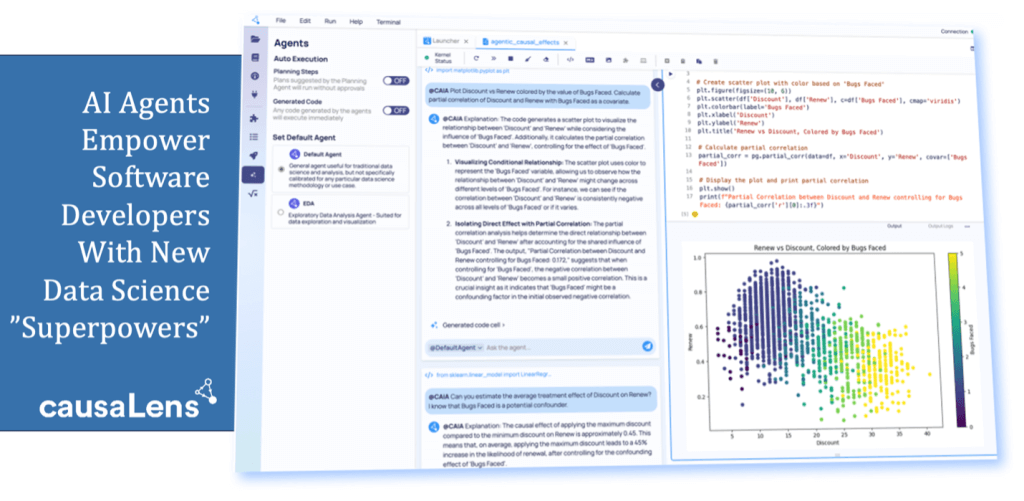
Recent data collected by theCUBE Research illustrates this trend vividly, with software developers acquiring AI and data science skills projected to grow at a remarkable compound annual growth rate (CAGR) of 36%, adding around 800,000 developers annually by 2030.
Moreover, the broader category of AI-focused software engineers will also see substantial growth, increasing by approximately 200,000 developers yearly at a CAGR of 30%. This shift underscores a profound evolution within the software development profession, reshaping developer roles toward those of data science generalists capable of addressing broader and more complex AI-driven business challenges.
Paul Nashawaty emphasized that this convergence is driven by practical necessity—businesses increasingly prefer generalists who can integrate software engineering and data science skill sets. Organizations seek operational efficiencies and rapid innovation cycles, utilizing AI tools to enhance developer productivity and effectiveness. Thus, developers are increasingly expected to apply data science principles to their work, managing AI models, addressing data quality issues, and incorporating predictive analytics directly into their application development workflows.
The transformation of developers into data scientists reflects a strategic response to growing market demands for agility, innovation, and efficiency in a data-driven and AI-centric era. Businesses adopting this hybrid skillset approach stay competitive and enable their developers to focus on higher-value, strategic tasks, thus amplifying their overall innovation potential.
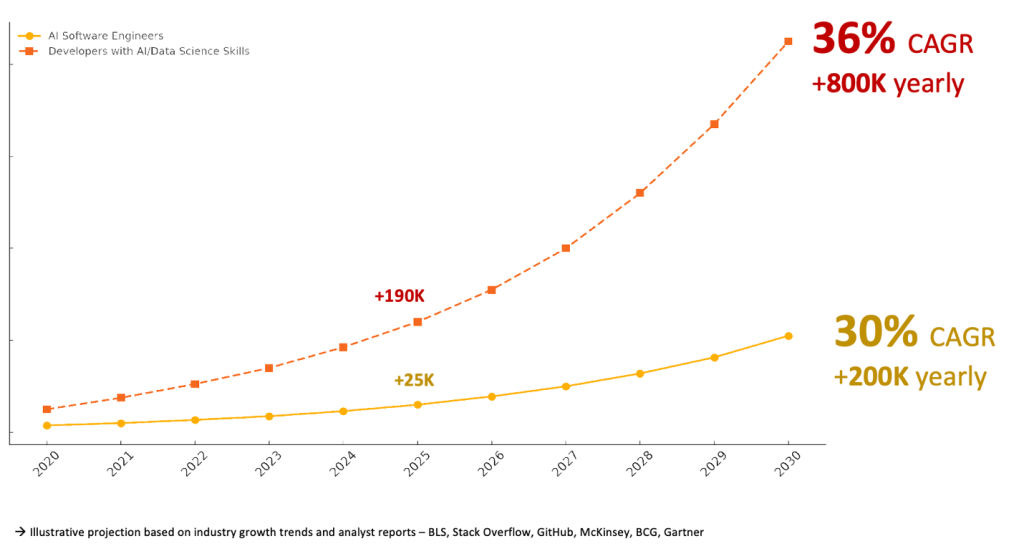
Practical Insights and Recommendations
Drawing from Nashawaty’s extensive market research, organizations currently deploying AI report significant productivity gains when integrating SDLC methodologies. Nashawaty cited research indicating enterprises with well-integrated SDLC and AI processes experienced fewer production issues and faster deployment cycles, directly translating into measurable competitive advantages.
To leverage SDLC effectively, organizations should:
- Implement AI-aware SDLC frameworks that facilitate iterative development, continuous integration, and rapid response to dynamic data environments.
- Maintain flexibility within the SDLC process, enabling rapid experimentation, validation, and adjustment of AI models.
- Promote cross-functional skill development among software developers encouraging proficiency in data science, AI tooling, and lifecycle management.
Nashawaty emphasized:
“The future belongs to organizations that successfully integrate SDLC practices with AI, creating robust yet agile development processes.”
Nashawaty predicts continued consolidation around AI-integrated SDLC platforms. Vendors like IBM WatsonX, AWS SageMaker, and emerging platforms are anticipated to deepen integration with lifecycle management tools, embedding robust AI governance, observability, and compliance mechanisms.
The podcast discussion also highlighted the necessity of software-driven orchestration tools for effectively managing complex, multi-agent AI ecosystems. These tools will be essential in coordinating the interactions of AI models and agents, ensuring coherent and reliable outcomes.
Paul Nashawaty offered a forward-looking vision, stating,
“We’re likely to see significant consolidation around platforms that unify AI and SDLC functionalities. Organizations will gravitate toward vendors who offer streamlined, cohesive solutions that reduce complexity.”
While acknowledging the benefits, Nashawaty also discussed potential friction points when integrating AI and SDLC platforms. One critical challenge is managing the balance between agility and governance.
“There’s always a risk of slowing innovation if governance processes become too cumbersome,” he cautioned. “Organizations must carefully calibrate their SDLC integration to ensure it enhances rather than hinders their ability to innovate.”
Additionally, organizations face a practical challenge regarding tool fragmentation. According to Nashawaty’s research, 75% of enterprises currently use multiple disparate tools across their development lifecycle, creating complexity and inefficiency. A unified, integrated platform is essential for overcoming these challenges.
What to Do and When
Integrating SDLC platforms within AI workflows is not merely beneficial—it is essential. Organizations must thoughtfully evolve their SDLC practices, emphasizing agility, flexibility, and cross-disciplinary skills among developers. Those that act proactively in aligning AI development with robust lifecycle methodologies will significantly enhance their innovation capacity, ensuring long-term competitive differentiation in the rapidly evolving landscape of Agentic AI.
As Nashawaty concludes,
“Ignoring the integration of SDLC and AI workflows is no longer an option. Organizations must adopt integrated approaches now—or risk falling irretrievably behind their competitors.”
We encourage you to attend the AI Agent Builder Summit on April 16th, where you can hear from industry pioneers on how they are balancing the world of Agentic AI and application development.
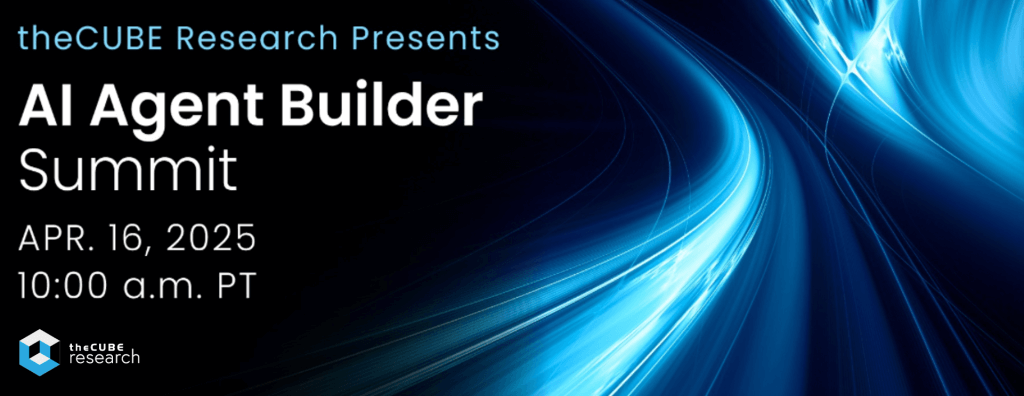
Also, mark your calendar for the June 11th AppDev Done RIght Summit to learn more about the future of software and application development.
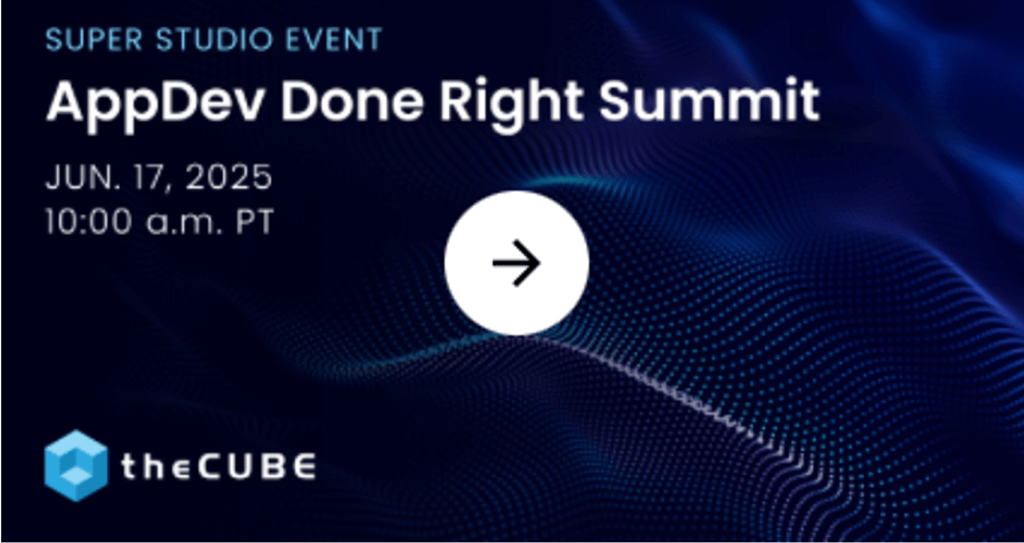
As always, let us know if we can help you!
We also recommend subscribing to the Next Frontiers of AI Podcast on the SiliconANGLE Media YouTube Channel or on Spotify to hear from industry experts and pioneers on what is shaping the future of AI in business.
Thanks for reading. Feedback is always appreciated.

